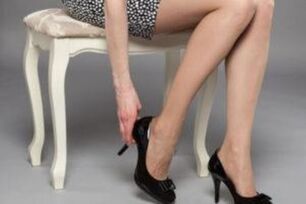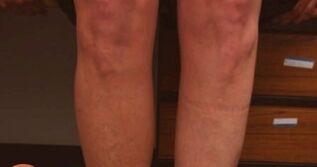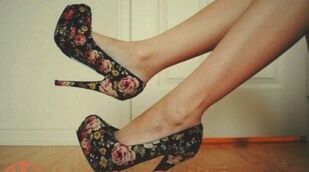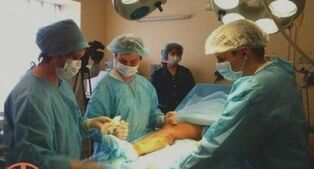Varicose veins are a common pathological process that is accompanied by varicose veins, nodules and blood stasis. Internal varicose veins on the legs are characterized by the nodular structure of the venous vessels on the epidermis. At the initial stage of the disease, there are no symptoms. Many people have a question about what should be the treatment of this ailment.
What is this disease?

Varicose veins of the lower extremities are a very dangerous disease that can be fatal. This is a pathological lesion of the organs of the circulatory system. With the complication of the disease, an irreversible process of stretching and stretching of the veins is observed.
Nodules begin to form in the capillaries, which impede the normal flow of blood. With varicose veins of the deep veins, the walls of the vessels expand so much that the functioning of the valves worsens. For this reason, the blood begins to stagnate in the legs.The disease affects mainly people from 30 to 40 years old.
Development reasons
The causes of this ailment can be very different. Among them are:
- hereditary factors (possible congenital anomaly or weakness of venous cells);
- is more common in females (in women, the disease is observed much more often due to the use of hormonal drugs, the risk also increases due to the postponed childbirth);
- increased pressure inside the veins (this is due to an inactive lifestyle, in the presence of excess weight);
- the presence of neuroendocrine changes; mechanical obstacles to normal blood circulation (this can be facilitated by constant compression of the limbs);
- the presence of allergic reactions;
- changes in the immune system;
- disorders in the functioning of the valves of the venous system;
- this pathology can begin to develop due to cellulite or dermatitis.
Before starting treatment, it is imperative to determine the root cause of the disease. An experienced phlebologist will help you do this.
Symptoms and manifestations of internal varicose veins
It is important to see a doctor in time,if varicose veins of the lower extremities appear. The symptoms of this disease at the stage of just the onset of varicose veins will be as follows:

- there is swelling of the extremities by the end of the day(this symptom is seen on the ankles and feet, edema may also appear in the lower half of the lower leg);
- the patient develops a feeling of heaviness in the area of the calf muscles(a feeling of fullness occurs after a long walk or standing, this symptom may appear after a long stay in a sitting position).
A characteristic feature of this ailment is the fact thatafter rest, all symptoms disappear without a trace.It also shrinks after a long rest.
During the period of gradual development of varicose veins, the following symptoms will begin to appear:
- in the area of the calf muscles, moderate pain begins to appear, such pains are dull and aching;
- local burning sensation and fatigue;
- excessive dryness of the skin appears, pigmentation spots and skin induration begin to appear;
- cramps very often at night;
- spider veins begin to appear on the epidermis;
- the internal veins on the legs, photos of which are presented below, begin to expand significantly, in their appearance they look like bunches of grapes;
- it is possible to form subtle wounds that heal for a long period of time.
Important!Untimely treatment of this disease for the patient can bring a number of complications. In some cases, a lethal outcome is possible.

After a period of time, eczema and trophic ulcers begin to appear. Such symptoms turn very easily into gangrene. All this can cause limb amputation, sepsis or death.
The most dangerous consequence is the occurrence of a blood clot, with its subsequent separation. This becomes the death of the patient.
Symptoms and treatment of latent varicose veins is the question that most concerns patients.
Treatment methods
Treatment for varicose veins is carried out conservatively and promptly. Treatment of internal veins in the legs, the symptoms of which can manifest themselves in different ways, is carried out only after preliminary diagnosis.The following techniques can be used:
- compression;
- scleropathy;
- medication;
- surgical.
Compression methodscures help to cope with the disease at its initial stage. This method of therapy involves daily wearing of special compression underwear.
In case of scleropathy, a vein is blocked. This is due to the introduction of sclero preparations into it. After such actions, the blood can easily move through the capillaries without difficulty.
Conservative cure is effective only if the first signs of the disease appear. Of the medicines, venotonics are prescribed to patients. They help to strengthen the walls of blood vessels as much as possible.
Independent treatment of internal varicose veins is prohibited, the symptoms of which can be both mild and vice versa.
Prevention
In order to prevent the formation of varicose processes, it is imperative to know the root causes of this ailment and prevent their development. Preventive measures are as follows:
- constant physical activity is necessary (People who lead an inactive way of life are much more susceptible to the disease. take breaks from time to time, get up and exercise so that the blood will circulate normally. );
- when sitting, it is forbidden to cross your legs;
- give up all bad habits;
- pay attention to your diet, refuse too fatty and salty;
- to take therapeutic measures in relation to endocrine ailments, they lead to the development of varicose veins;
- use only loose, non-squeezing shoes (it is necessary to ensure free circulation of blood, as well as restrict yourself in shoes with heels);
- take sea baths, but it is necessary to eliminate solar overheating.
Conclusion
It should be noted that if at least one symptom of this disease manifests itself, it is necessary to urgently consult a specialist. The doctor will prescribe diagnostic procedures and indicate the appropriate treatment. Delay threatens with complications.
From the above, we can summarize that hidden varicose veins is a very dangerous disease that can have undesirable consequences. It is for this reason that if at least one symptom appears, it is necessary to seek help from a doctor. Only a specialist will be able to select the necessary treatment.
Internal varicose veins on the legs: symptoms and treatment
The geography of the spread of varicose veins covers almost all countries of the world, it is one of the most ancient diseases known to mankind. According to medical statistics, varicose veins of the lower extremities and pelvic organs occur in 15-17% of the population. Today, patients with this diagnosis make up approximately 4% of all patients in surgical clinics. According to scientists, this disease is a kind of payment for humanity for the ability to walk upright. Let us examine what internal varicose veins are, the main symptoms of the disease, and effective treatment.
Explanation of the appearance of the disease
The development of internal varicose veins on the legs is one of the most dangerous types of the disease, which manifests itself in the pathological expansion of blood vessels located deep under the skin in the tissues.
This disease, unfortunately, often affects young people of working age, and in women, symptoms are much more common. Internal varicose veins on the legs are often accompanied by an external one in the form of strongly protruding tuberous veins with a pronounced cyanotic hue.
These symptoms of varicose veins make treatment difficult. The appearance of legs with varicose nodes is presented in numerous photos from medical sites.
Dilation of venous vessels on the legs can be an independent pathology, but most often it is caused by other diseases, and therefore in modern medicine it is customary to divide varicose veins into primary and secondary. The cause of primary varicose veins of the deep veins of the legs is the weakness of the venous wall or its functional pathologies, these reasons also cause varicose veins of the pelvic organs. Among the main causes of the disease stand out:
- Pregnancy.
- Overweight, morbid obesity.
- Prolonged load on the lower extremities, constant work on the legs or associated with constant heavy lifting.
- Hereditary or congenital weakness of the connective tissue of various organs.
- Long walking in high heels and wearing hosiery with tight elastic bands.
- In elderly patients, the formation of internal varicose veins can be caused by hormonal changes in the body.

The development of secondary internal varicose veins is a consequence of changes in the process of outflow of venous blood in various diseases:
- Post-thrombophlebic syndrome.
- Deep vein valve failure.
- Tumors of organs of various etiology.
- Injuries to limbs and other organs.
Treatment of primary and secondary varicose veins is different.
Main features
The consequences of a timely undetected internal varicose veins can be very serious, therefore it is necessary to pay attention to the very first symptoms of the disease, especially since, compared to other forms of the disease, they are very clearly manifested visually. The main symptoms of internal varicose veins of the lower extremities are manifested in the following:
- Pain in the calf muscles is very strong, often intolerable so much that the patient is forced to regularly take strong pain medications. These symptoms are the reason for immediate medical attention.
- The venous pattern on the lower extremities in the thigh area becomes pronounced, the vessels become strongly convex and tuberous, they are easily identified by palpation.
- The venous pattern acquires a cyanotic color, sometimes turning into black, sometimes into crimson-red.
- The lower extremities are very swollen, and the swelling does not diminish after a night's sleep.
- In the evening, after a working day on his feet, the patient experiences frequent cramps in the calf muscles.
All these symptoms significantly worsen the patient's quality of life and require immediate medical intervention, sometimes it is only surgical treatment of veins.

Clinical presentation
The severity of symptoms of internal varicose veins depends on the stage of the disease.
At the initial stage, pathological changes in the walls of blood vessels are not detected, patients have swelling of the legs by the end of the working day and heaviness in the legs, but after a night's rest, these unpleasant sensations disappear.
Some patients have a slight pastiness, this stage of the disease is called "intradermal varicose veins". If treatment is started at this stage of the disease, then the prognosis is very favorable, since the valve system of the veins has not yet been changed and copes with the load, the pathological symptoms will quickly go away.
At the second stage of the disease, edema of the lower extremities becomes permanent, patients complain of constant heaviness in the legs and increased fatigue. The manifestations of internal varicose veins at this stage of the disease are also indicated by constant cramps of the calf muscles and cold extremities.
A photo in medical publications shows that blood vessels begin to appear on the skin on the inner side of the thigh, but the zones of their appearance are not painful to palpation. At this stage, the formation of varicose veins begins, there may be bleeding from them.
These symptoms worsen very quickly, and if there is no treatment, the disease progresses to the next stage.
The third stage of varicose veins of the legs is already well defined visually, this can be seen in the photo from various medical sources.
Varicose veins and saccular enlargements caused by severe circulatory disorders are already well defined under the skin on the calves and inner thigh.
At this stage, in addition to the appearance of nodes, the patient has fragility and hair loss, dry skin, constant cramps in the calf muscles.
The fourth stage of the disease already entails serious complications (bleeding, ulcers, etc. ), which can be fatal. You need to start treating the disease immediately, without waiting for formidable symptoms.
Complications
These include the following:
Trophic ulcers of the skin of the legs.
This is a very painful complication for the patient, since trophic ulcers heal very slowly, and the patient experiences constant itching and burning in the places of their localization.
The photo clearly shows that ulcers are round in shape, brightly colored and with different types of secreted secretions: purulent, hemorrhagic or serous discharge. They appear on the calves and on the inside of the thigh.
With competent and timely therapy, scarring of ulcers begins, but if there is no help or is not provided qualified, the patient may develop gangrene followed by amputation of the limb. Death is also possible.
Traumatic bleeding.
Massive bleeding may be due to rupture of a vessel due to thinning of the venous wall under constantly increasing blood pressure or due to minor trauma. This syndrome is especially dangerous because bleeding can lead to the death of the patient.
Thrombosis is a consequence of congestion and inflammation in the veins of the lower extremities. Thrombosis can be visually manifested only in leg swelling and severe pain in it.
With the formation of external venous nodes, thrombosis is accompanied by severe pain in the area of thrombus formation, vein tenderness on palpation and fever in the area of thrombosis.
Thrombosis is very dangerous for the patient's life and requires urgent hospitalization and treatment, since it can provoke a heart attack and blockage of the pulmonary artery in the patient.

Principles of Therapy
It is very difficult to treat internal varicose veins on the legs, and the effectiveness of therapy largely depends on the stage of the disease.
The general principles of treating the disease include the normalization of hormonal levels, optimization of physical activity and adherence to diet.
If the patient is obese, it is necessary to develop a weight loss method and monitor its implementation. To normalize the tone of the vessels of the lower extremities, it is recommended to use compression hosiery.
The most effective method of treatment is surgery, the technique of which is well developed in modern surgery. A possible complication of the operation is bleeding from a vein, but the risk is low.
If for some reason surgical intervention is impossible, for example, if the patient fears that life-threatening bleeding will begin, treatment is carried out medically using the following groups of drugs:
- Antiplatelet agents - to thin the blood and prevent blood clots.
- Phlebotonics - to normalize blood circulation and prevent edema.
- Nitrates - to relieve pain symptoms.
- Angioprotectors - to normalize vascular tone.
- Non-steroidal anti-inflammatory drugs - to reduce the possibility of platelet adhesion and relieve pain.
Many sources recommend treating varicose veins with folk remedies, on the Internet you can find many photos of calves and thighs in the "before" and "after" style on sites that advertise traditional medicine and guarantee 100% recovery. Doctors are very wary of such drugs and warn that they can only be used as part of complex therapy.
Internal varicose veins on the lower extremities is a serious systemic disease that requires timely and qualified treatment. The first alarming symptoms cannot be ignored. The sooner the patient seeks a doctor, the more effective the treatment will be.
Main characteristic symptoms
Specialists distinguish three stages of varicose veins of the lower extremities - compensation, subcompensation and decompensation.
Respectively correspond to light, medium and severe course. In some cases, more than one year passes between the onset of the disease and the onset of symptoms.
There is practically nothing to worry about during compensation. During a strong overstrain of the body, minor pains in the limbs are possible. Distal swelling that subsides after sleep.
Some people report feeling like spiders or goosebumps are crawling down their legs. This is a consequence of impaired blood flow and tissue trophism.
The deep vein valve apparatus is largely intact. Visible superficial changes in the skin and veins are usually not observed.
Subcompensation is characterized by a more severe clinical picture. Pains come on more and more often. They wear sharp dagger pain. An ordinary touch can be a whole hard labor.
Patients cannot walk normally. The usual shopping trip is debugged to the last.
The legs are swollen to a large extent, exceeding the normal volume of the leg by one and a half times. Often, such swelling does not subside even after prolonged sleep. Traces of depressed fingers remain on the shins. Many people note cramps in the calf muscles.
During decompensation, there are often signs of bleeding, thrombophlebitis and thrombosis, trophic ulcers.
Complications arising from the development of internal varicose veins
The most common complication of varicose veins is bleeding. If not diagnosed in a timely manner, it can be fatal. Even minor bleeding from varicose veins of the lower extremities can cause irreparable harm. Stopping such a defect with a conventional pressure bandage often fails. Many surgeons come to the ligation of vessels or their coagulation.
The second most frequent complication is the addition of infections during the development of trophic ulcers. Due to a decrease in tissue trophism, abscesses do not heal for a long time, a chronic purulent focus is formed.
It is accompanied by general intoxication of the body, febrile temperature, profuse sweating. Such wounds take a very long time to heal. It depends on the degree of tissue trophic disturbance and the depth of the lesion.
Ulcers should not be bandaged frequently, as this can cause crusts that have begun to form and lead to re-formation of an open wound.
The next most common complication is deep vein thrombosis. With poor motor function, the blood stagnates and the risk of blood clot formation increases, which in turn can cause pulmonary embolism.
Vascular surgeons are more afraid of a floating thrombus, since it is its distal part that tends to break off and lead to embolism.
Treatment methods
Treatment of internal varicose veins of the lower extremities takes place in several stages.
Drug therapy is the most popular direction that can be used at all stages of varicose veins, as well as for the prevention of vascular problems.
The basis of conservative treatment is the intake of venotonic drugs. They help to strengthen the vascular wall, increase its elasticity and reduce blood stagnation. It is better to apply them internally and also externally at the site of the lesion.
There are several classes of underwear that is used for different stages of the disease. A lot of models will be able to satisfy the individual desire of each person, I have only positive reviews.
When worn under clothing, do not cause any discomfort or irritation.
Proper and balanced nutrition is one of the important points in the treatment of varicose veins of the lower extremities. It is necessary to radically limit yourself in the consumption of salt and large amounts of fluids. The use of natural fruit drinks and juices is desirable.
Nutrition should strictly correspond to human energy consumption and contain fewer calories in order to avoid overweight. You should limit yourself in the consumption of fatty and fried foods, spicy and sour. You need to give preference to vegetables and fruits. Introduce seafood, fermented milk dishes and products containing digestible carbohydrates into the diet.
In case of ineffectiveness of the methods of conservative therapy, they resort to surgical techniques. These include both invasive and minimally invasive treatments.
Prevention of pathology
Knowing the dangers of deep vein varicose veins, many want to prevent its occurrence in advance. To do this, you do not need to follow strict rules, you just need to bring your lifestyle back to normal.
The main preventive measure is regular feasible physical activity.
You can do gymnastics, yoga, walking, swimming, or even dancing to reduce your risk of developing many diseases.
In addition, it is advisable to completely or at least partially give up bad habits. It is recommended to regulate the work and rest schedule in order to give your body at least a short break.
It would be useful to adjust the diet with the exception of fried, fatty, smoked, pickled, overly spicy or salty foods. You need to eat more vegetables and fruits.
Regular contrast showers and relaxing foot baths are good preventive measures.












































